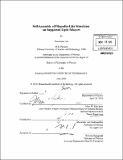Self-assembly of filopodia-like structures on supported lipid bilayers
Author(s)
Lee, Kwonmoo
DownloadFull printable version (7.497Mb)
Alternative title
Self-assembly of FLSs on supported lipid bilayers
Other Contributors
Massachusetts Institute of Technology. Dept. of Physics.
Advisor
Marc W. Kirschner.
Terms of use
Metadata
Show full item recordAbstract
Filopodia are finger-like protrusive structures of cells, comprised of actin bundles, which can serve as sensory organelles. To probe their pathway of assembly we have reconstituted filopodia-like structures (FLSs) by applying frog egg extracts to supported lipid bilayers containing phosphatidylinositol(4,5)bisphosphate, PI(4,5)P 2. The FLSs recapitulate important characteristics of filopodia - they assemble parallel actin bundles from the lipid membrane and they form in the presence of capping activity. Known filopodial tip components such as Diaphanous-related formin and VASP localize to the membrane base of the structures, and bundling protein fascin to the shaft. Actin subunits assemble at the tip and translocate into the shaft. FLS assembly requires negativelycharged lipid membranes, with specific requirements for PI(4,5)P 2 and, for maximal efficiency, phosphatidyl-serine. The focal nature of FLSs is not a result of templating by PI(4,5)P2 microdomains but instead by the self-organization of tip complex assembly on uniform PI(4,5)P 2-enriched regions. BAR domain protein toca-1 recruits N-WASP then the Arp2/3 complex and actin assembly follow. Elongation proteins Diaphanous-related formin, VASP and fascin are recruited later. The Arp2/3 complex is absolutely required for FLS initiation but is not required for elongation, which may involve multiple factors including formins. We propose a model for filopodia formation involving an initial clustering of Arp 2/3 complex regulators, self-assembly of filopodial tip complexes on the membrane, resulting in the outgrowth of parallel actin bundles.
Description
Thesis (Ph. D.)--Massachusetts Institute of Technology, Dept. of Physics, 2010. Cataloged from PDF version of thesis. Includes bibliographical references (p. 98-121).
Date issued
2010Department
Massachusetts Institute of Technology. Department of PhysicsPublisher
Massachusetts Institute of Technology
Keywords
Physics.